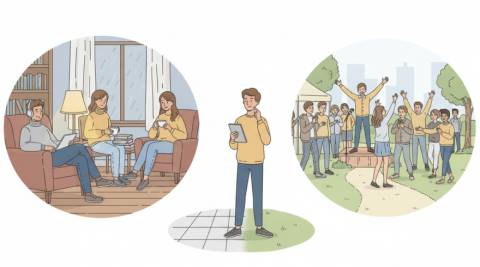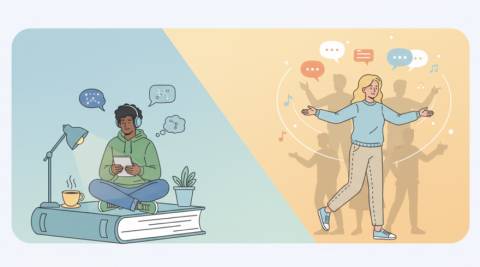Understanding Introversion: Science, Benefits, and Real-Life Strategies

What Does Introversion Really Mean?
Introversion isn’t a flaw to be “fixed” or a quirk to be excused; it is a well-documented orientation of attention and energy. People who lean inward often recharge through quiet reflection, deep thinking, and one-on-one connection. Rather than a simple preference for solitude, this tendency shapes how the mind filters stimulation, how attention is allocated, and how social energy is renewed. In practice, introversion can look like savoring long stretches of focus, listening carefully before speaking, and valuing meaningful dialogue over small talk.
Across daily life, the concept becomes clearer when we separate cultural myths from psychology. In everyday conversation, the query is introvert a personality pops up as people parse labels, and nuanced research clarifies that temperament exists on a spectrum shaped by biology and environment. While outward behavior varies, the core pattern centers on internal processing and measured engagement. That orientation leads some to choose deliberate routines, thoughtful responses, and creative solitude, all without rejecting social connection.
Misconceptions fade once we consider the long arc of temperament science and lived experience. Within this context, scholars describe an introverted personality as a constellation of traits, sensory sensitivity, depth of focus, and preference for lower stimulation, that can guide career choices, learning styles, and relationship rhythms. Though social energy might be finite, depth often flourishes, yielding sustained attention, meticulous craftsmanship, and a calm presence under pressure. When embraced, this orientation nurtures authenticity and a resilient inner life.
- Energy returns through reflective time and low-stimulus environments.
- Conversation favors depth, nuance, and attentive listening.
- Creativity thrives when distractions are minimized and focus is protected.
The Spectrum From Solitude to Sociability
Personalities are not rigid boxes; they unfold along a continuum from inward-focused to outward-oriented. Social context, mood, and goals can nudge anyone to the left or right of center on any given day. Rather than forcing a binary, it helps to picture a dial that turns as circumstances change. That dial explains why one person loves book club on Friday yet craves silence on Saturday, or why another person thrives at networking events but still seeks a quiet walk to recover.
Comparisons between orientations can be helpful when handled respectfully and with nuance. In workplace discussions about collaboration styles, people sometimes reference an extrovert personality to highlight comfort with high-energy environments, yet teamwork benefits from a full range of cognitive rhythms. Meetings that alternate between open brainstorming and quiet writing time, for instance, let multiple modes shine. The payoff arrives in better ideas, broader inclusion, and less burnout.
| Orientation | Primary Energy Source | Practical Tip |
|---|---|---|
| More Inward-Focused | Solitude, reflection, depth | Block focused time; use agendas to reduce noise |
| Balanced Middle | Mix of quiet and social input | Alternate between collaborative sprints and solo work |
| More Outward-Oriented | Social stimulation, rapid exchange | Leverage group sessions; recap decisions in writing |
Language about styles can take many forms, and careful wording avoids stereotypes while acknowledging differences. In talent development guides, authors sometimes discuss extroverted personality types to plan team balance, and those same guides advocate environments where quiet contributors can prepare thoughts in advance. When teams normalize written input, rotating facilitation, and focused breaks, group intelligence rises and decision quality improves.
- Rotate meeting formats to include silent brainstorming and discussion.
- Offer multiple channels: live conversation, chat, and written memos.
- Respect recovery time after high-stimulus events to prevent fatigue.
The Unique Benefits of Being Introverted
While every individual has a blend of traits, certain strengths consistently emerge among people who recharge through solitude. Deep concentration enables sustained progress on complex tasks, and a rich inner narrative supports creative problem-solving. Many describe a heightened sensitivity to nuance, which leads to insightful questions, careful analysis, and empathic responses. Rather than chasing constant stimulation, the focus rests on meaning, craftsmanship, and purpose.
Career coaches often highlight clusters of strengths to show how focus can become a professional edge. In guidance sessions, counselors map how introvert personality types channel attention toward research, writing, design, and systems building, making them well-suited to roles that reward persistence. With intentional boundaries, these strengths scale, transforming careful thought into high-quality output and reliable execution.
Balanced teams recognize complementary qualities and build processes that honor diverse rhythms. In capability frameworks, leaders sometimes compare introvert and extrovert personality traits to plan handoffs, where quiet analysis feeds into energetic presentation. When that workflow is deliberate, everyone benefits: insights are richer, risks are surfaced earlier, and communication lands with clarity. The result is a calmer culture that still ships bold ideas.
- Depth of focus supports complex learning and mastery.
- Listening first helps uncover hidden constraints and opportunities.
- Measured pacing reduces errors and calms chaotic projects.
Assessments and Self-discovery
Self-awareness grows when reflection meets data. Journaling, feedback from trusted peers, and well-constructed assessments can illuminate patterns in energy, attention, and decision-making. No single tool defines you, yet structured questionnaires can offer language for preferences and blind spots. With that language, you can advocate for better work conditions, set healthier boundaries, and articulate needs in relationships.
Responsible use of instruments begins with understanding their limits and strengths. In many career centers, advisors emphasize that a personality test introvert extrovert highlights tendencies, not destiny, so results should guide experiments rather than impose labels. The smartest approach treats reports as hypotheses to test: try new schedules, adjust meeting loads, and track how focus and mood shift across environments.
Quick quizzes can prompt reflection when used with curiosity and care. After initial results spark insight, some people try a personality quiz introvert extrovert again months later to see whether habits or contexts changed their responses. That iterative stance, observe, tweak, re-measure, turns self-knowledge into practical routines that protect energy and amplify strengths over time.
- Use results to negotiate work patterns that fit your focus windows.
- Pair assessments with real-world experiments and weekly reviews.
- Seek multi-source feedback to capture how others experience your style.
Thriving in Work, School, and Relationships
Flourishing as a reflective person requires designing environments that refill the tank. Thoughtful scheduling, clear boundaries, and intentional recovery rituals make a profound difference. You can build a cadence that alternates concentrated work with genuine rest, while also cultivating relationships through purposeful, small-group conversations. Over time, these practices convert temperament awareness into steady progress and sustainable wellbeing.
Some people recognize a blend of inward focus and outward ease and want language that respects that nuance. In coaching sessions, mentors may describe an introverted extrovert personality type to capture those who enjoy social energy yet still crave deliberate downtime, and that description helps normalize flexible routines. Designing a week around fluctuating needs can preserve zest without sacrificing depth.
Relationships also improve when preferences are named and honored. Among friends and partners, you might hear about an introverted extrovert personality as a shorthand for someone who shines at gatherings but later needs silence, and that clarity reduces misunderstandings. When people align on signals for overload, shared calendars, and decompression rituals, connection feels easier and more resilient.
- Batch high-interaction tasks, then protect a recovery window afterward.
- Favor meaningful meetups over frequent, low-value check-ins.
- Create micro-havens: noise-canceling headphones, quiet corners, and walks.
FAQ: Clear Answers About Introversion and the Social Spectrum
Is introversion the same as shyness?
No. Shyness involves fear of negative judgment, while introversion reflects how you regain energy. After a stimulating day, an introverted person might feel drained but not anxious about people. For comparison, some educational materials mention the extrovert personality type to illustrate a different recovery pattern, yet both orientations can be confident, socially skilled, and compassionate. The key distinction is where energy is lost and replenished.
Can someone be both inward-focused and socially comfortable?
Yes. Many people enjoy parties and presentations while still needing quiet time afterward to recharge. By noticing early signs of depletion, you can schedule downtime and protect your best hours for high-focus work. That intentional balance keeps motivation steady and helps your social life remain enjoyable without tipping into exhaustion.
Do labels limit growth?
Labels can help with language, but should never become cages. Use any descriptor as a working hypothesis that guides experiments in routine, collaboration, and rest. In personality research, debates sometimes reference personality types extrovert, when discussing historical models, yet modern approaches emphasize fluid spectrums over rigid boxes. Growth thrives when self-knowledge informs habits instead of constraining potential.
How can teams support varied energy patterns?
Teams thrive when they normalize multiple pathways to contribute. Rotating facilitation, adding silent idea rounds, and documenting decisions in writing invite broader participation. Clear agendas, time-boxed discussions, and focused breaks also help sustain momentum while preventing social fatigue during long projects or high-stakes meetings.
What daily practices help introverted people recharge?
Short reflection windows, mindful walks, and tech-free blocks restore attention and calm the nervous system. You can pair those rituals with boundary cues, status lights, calendar holds, or concise auto-replies to defend focus without friction. Over weeks, small, steady adjustments compound into resilient energy and reliably good work.
Latest News



